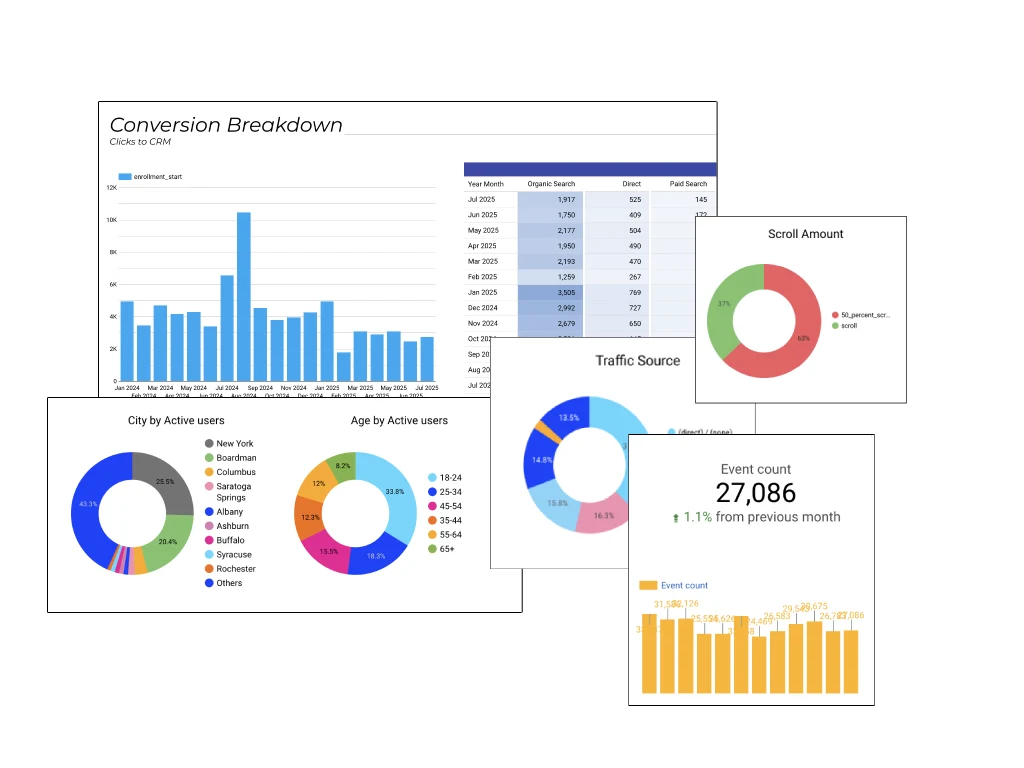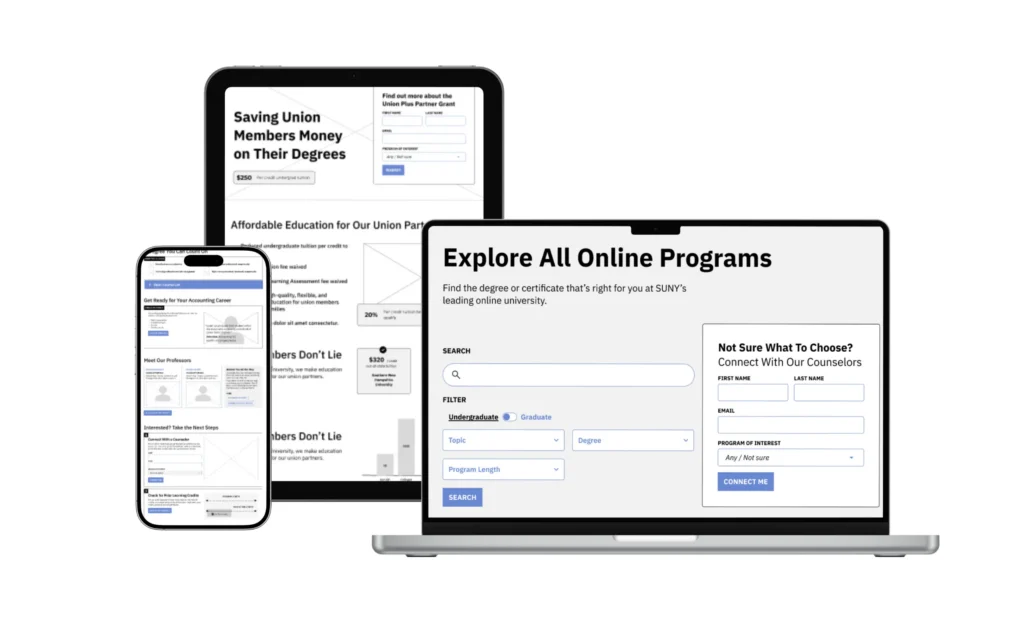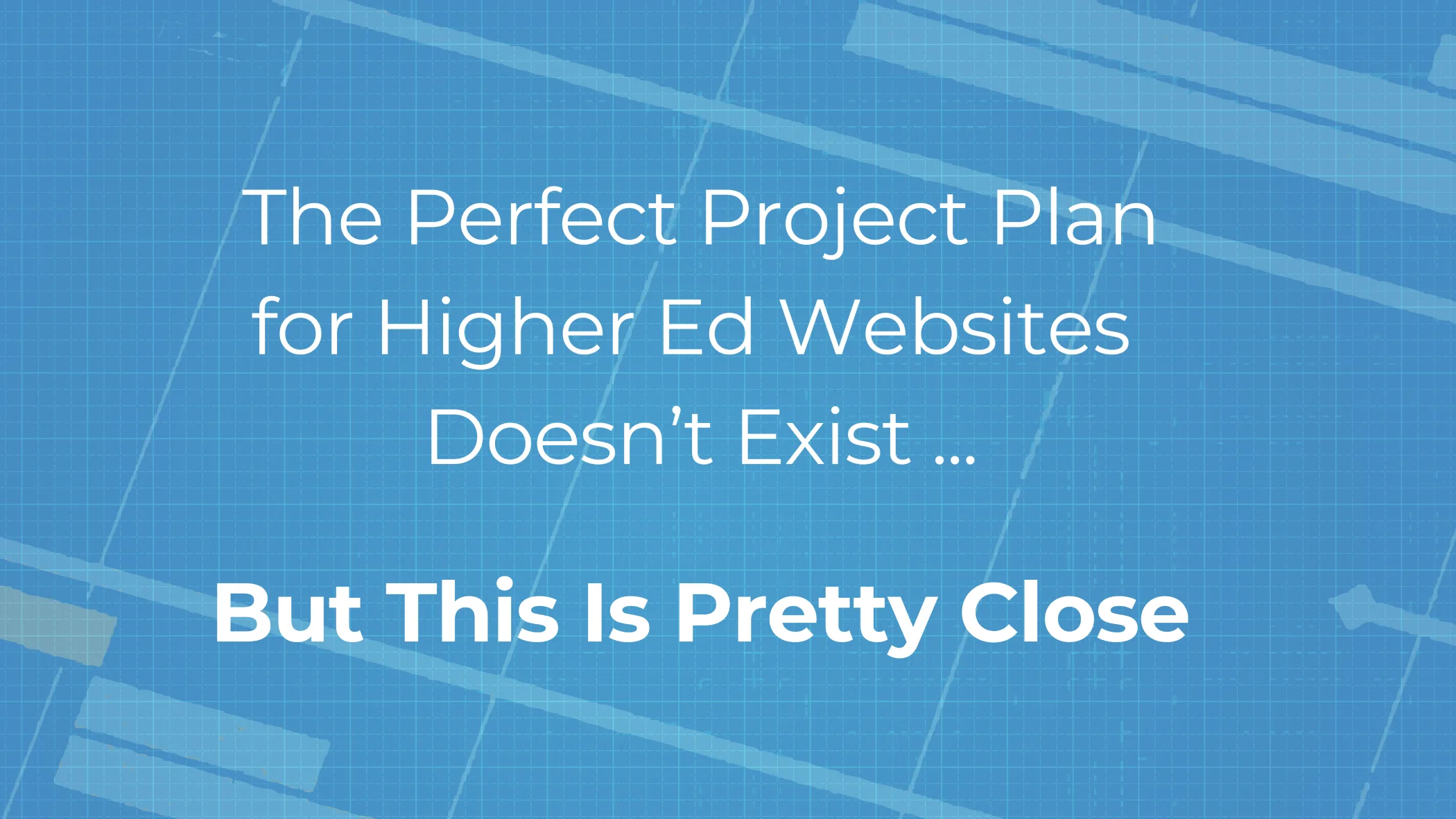Shared ownership of content and changing priorities in institutions add to this complexity. Therefore, it is clear that no single plan can perfectly meet every need.
Here’s the good news: with the right approach, you can create a project plan that is flexible and collaborative. It can be as close to perfect as possible. No matter if you lead marketing, IT, or are a key stakeholder, a clear framework is essential. It helps you handle the complexities of redesigning your institution’s digital front door.
Here’s a breakdown of what an ideal, adaptable project plan looks like — and how it can set your team up for success.
Get Clear on Your Goals: Define What Success Looks Like
Before you start planning the details, it’s important to define what success means for your website redesign. Without clear goals, the project can easily veer off course or get bogged down by conflicting priorities.
- Align on Objectives: Start by asking, “What are we trying to achieve with this redesign?” Whether it’s improving accessibility, increasing prospective student engagement, streamlining internal processes, or modernizing the user experience, your goals should be specific and measurable.
- Define Key Performance Indicators (KPIs): How will you know if you’ve succeeded? Find metrics that match your goals. These can include more application starts, fewer bounce rates, or better task completion rates for important user journeys.
- Document and Share: Make sure everyone in the project, from leaders to content creators, understands these goals. This shared understanding will help guide decisions throughout the project and keep everyone focused on what matters most.
Defining your goals upfront will serve as your project’s North Star, ensuring that all efforts align and remain purposeful.

Discovery: Laying the Foundation with Research and Insights
Every great website project starts with discovery. This phase is your chance to understand your users, stakeholders, and the current state of your digital presence. Skip this step, and you risk investing in a site that doesn’t meet the needs of its audience.
- User Research: Dive into the needs and behaviors of your prospective students, current students, alumni, faculty, and staff. Surveys, focus groups, and usability testing can provide invaluable insights.
- Stakeholder Interviews: Higher ed websites often serve multiple departments with competing priorities. Talking to key stakeholders early ensures that they express their voices and manage their expectations from the start.
- Analytics Review: Your current website has a story to tell. Look at user behavior, traffic patterns, and bounce rates to identify what’s working — and what’s not.
By the end of discovery, you should understand your audience’s needs. You should also know your internal goals and the gaps your redesign must address.
Change Management and Expectation Setting: Building a Collaborative Foundation
Before you dive into design or development, take time to align your teams and establish a governance structure. This phase is all about setting expectations, preparing for challenges, and ensuring decision-making is as smooth as possible.
- Project Governance: Define clear roles and responsibilities. Who’s the ultimate decision-maker? Who’s providing input, and who’s simply being kept informed? Establishing this early prevents confusion later.
- Team Alignment: Ensure everyone understands the project’s goals, timeline, and constraints. This is especially important in higher ed, where decentralized content ownership can lead to conflicting priorities.
- Preparing for Bottlenecks: Decision-making delays are inevitable in higher ed. Identify potential roadblocks (e.g., committee reviews, academic calendars) and build buffer time into your schedule.

Aligning the community is a crucial step. It is important to listen to internal stakeholders, even if they don’t agree with the goals of the project. For more tips about listening to the community, read Pete Gaioni’s blog post “Everyone Gets a Voice, not a Vote“.
Using Great Project Management Tools: Keeping Everything Organized
With so many moving parts, stakeholders, and deadlines, having the right project management tools in place is essential for keeping your website redesign on track. These tools help centralize communication, streamline workflows, and ensure that nothing falls through the cracks.
- Centralizing Communication: Tools like Teamwork help you organize discussions, tasks, and updates in one place. This cuts down on the chaos of endless emails and scattered notes.
- Tracking Progress: Use tools to create timelines, assign tasks, and set deadlines. For example, Teamwork’s ticketing system helps track tasks like content updates or design changes. This way, all team members know what is expected and when.
- Improving Collaboration: Project management tools help everyone work together. They allow for reviewing wireframes, managing feedback, and coordinating content migration. These tools create a shared workspace for all contributors. This fosters transparency and accountability.
Spending time to set up a good project management tool will save you many hours later. It will also help avoid questions like, “Where is that file?” or “Who is in charge of this task?” moments that can derail progress.
Information Architecture and UX Design: Structuring for Success
Your website’s structure and user experience (UX) are critical to its success. This phase is where you map out the framework that will guide users to the information they need.
- Site Structure Planning: Create an information architecture that’s intuitive for users, prioritizing accessibility and ease of navigation. Use simple language that is easily understood by your primary target audiences.
- Sharing Wireframes: Involve key stakeholders in wireframe reviews to ensure the site reflects institutional priorities while staying user-centric.

Iterative Design: Embracing Feedback and Refinement
Design is rarely perfect on the first try, nor should it be. An iterative approach allows you to gather feedback and refine your designs to meet user and stakeholder needs.
- Room for Feedback: iFactory’s multiple iteration approach of Art Direction to Design Strategy to Layout Design allows for regular checkpoints with stakeholders to review designs and provide input.
- Flexibility in Refinement: Be open to revisiting elements if feedback reveals opportunities for improvement.
- Using Collaborative Tools: Tools like Figma help teams work together. They let stakeholders leave comments right on the design files. This keeps feedback centralized and actionable, reducing the risk of miscommunication and ensuring everyone is on the same page.
By embracing tools that facilitate collaboration, your team can stay agile and ensure that the final design truly reflects the needs of both users and stakeholders.
User Testing: Designing for Real People
Testing your designs with real users is non-negotiable. This step ensures your website is intuitive, accessible, and effective before it goes live.
- Prospective Students: Your website is often their first impression of your institution. Test with this group to ensure key information is easy to find and resonates with their needs.
- Internal Stakeholders: Often, the site is not primarily for internal stakeholders, but faculty, staff, and administrators often understand the questions frequently asked by students and families. Review the work with them to make sure key questions are being easily answered in language that students and their families can understand.
- Accessibility Testing: Higher ed websites must comply with accessibility standards. Test with users who have disabilities to identify and address potential barriers.

Content Planning and Migration: It’s More Work Than You Think
Content is often the most underestimated part of a website redesign. It’s time-consuming, detail-heavy, and critical to your site’s success.
- Start Early: Content planning and migration take longer than expected. Begin auditing and drafting content as early as possible.
- Get a Clear Content Migration Plan: Define a detailed plan for how your existing content will be reviewed, edited, and transferred to the new site. This includes:
- Identifying content owners for each section of the site.
- Creating a timeline for reviewing and editing content.
- Mapping old content to the new site structure to ensure nothing important is lost.
- Ownership and Approval: Clearly define who’s responsible for creating, editing, and approving content. This is especially important in decentralized institutions.
Having a clear plan will ensure the migration process is organized, efficient, and free of last-minute surprises.
Development and QA: Building for Performance and Accessibility
Once your designs and content are finalized, development begins. This phase is about translating your plans into a functional, high-performing website.
- Accessibility First: Ensure the site meets WCAG standards to provide an inclusive experience for all users.
- Performance Optimization: Speed matters. Optimize images, code, and functionality for fast load times.
- CMS Training: Your team will need to manage the site after launch. Include CMS training to ensure they’re comfortable and confident.
Launch Planning: Preparing for a Smooth Transition
A successful launch requires careful planning and clear communication. This is your chance to align your teams and ensure a seamless transition.
- Internal Alignment: Confirm that all stakeholders are on the same page about the launch timeline and expectations.
- Technical Setup: Double-check domain configurations, redirects, and analytics tracking to ensure a smooth go-live process.
- Stakeholder Communication: Keep everyone informed about the launch, including what to expect and how to report issues.
Adapting for Your Institution
No two higher ed institutions are alike. Each has its own structure, priorities, and challenges. The beauty of this project plan is that it’s adaptable. By staying flexible and collaborative, you can tailor these phases to meet your institution’s unique needs while staying focused on delivering a user-centric website.
Conclusion: It’s Not Perfect, But It’s Pretty Darn Close
A “perfect” project plan may not exist, but this framework is as close as it gets. Start with clear goals. Follow these phases and stay flexible to meet your institution’s needs. This way, you will be ready to handle the challenges of redesigning a higher ed website.
Remember, collaboration is key. The more you involve your teams, listen to users, and prepare for challenges, the closer you’ll come to success.
Tools like Teamwork and Figma can be game-changers for keeping everything organized and encouraging collaboration. So, roll up your sleeves, rally your stakeholders, and get ready to create a website that truly serves your institution and its audiences. And enjoy the process. It can be very challenging – but truly rewarding when you hit those goals.
Looking for a partner to help support your website redesign? We would love to speak with you about any upcoming projects.
A website redesign allows higher education institutions to stay competitive, better meet user needs, and communicate their mission effectively. It’s a chance to modernize the user experience, improve accessibility, optimize for mobile devices, and align the website with institutional goals.Additionally, a redesign ensures your site is prepared for the future of search, including SEO (Search Engine Optimization) best practices and AI-driven search trends. With tools like AI-powered search engines and voice search becoming more common, today’s prospective students are using more conversational, question-based queries to find schools. A redesign provides the opportunity to improve your site’s content and structure to rank well for these searches, helping your institution stay visible to the next generation of students.
A typical higher ed website redesign takes 6 to 18 months, depending on the institution’s size, complexity, and resources. Factors like stakeholder alignment, content creation, and user testing can extend the timeline. Building flexibility into your schedule for unexpected delays is essential to staying on track.
Content migration is often underestimated in complexity and time. To manage it effectively:
- Start with a content audit to identify what content to keep, update, or remove.
- Look at the current site analytics to understand current high value pages.
- Create a clear migration plan that maps old content to the new site structure.
- Assign ownership for content review, updates, and approvals.
- Begin the process early to avoid bottlenecks during development.
Some common challenges include:
- Aligning multiple stakeholders with competing priorities.
- Managing decentralized content ownership while maintaining consistency.
- Balancing user-centric design with institutional messaging.
- Underestimating the time and effort needed for content clean-up and migration.
- Navigating decision-making bottlenecks, especially in committee-driven processes.
Planning ahead for these challenges and building in flexibility can help your project stay on track.


